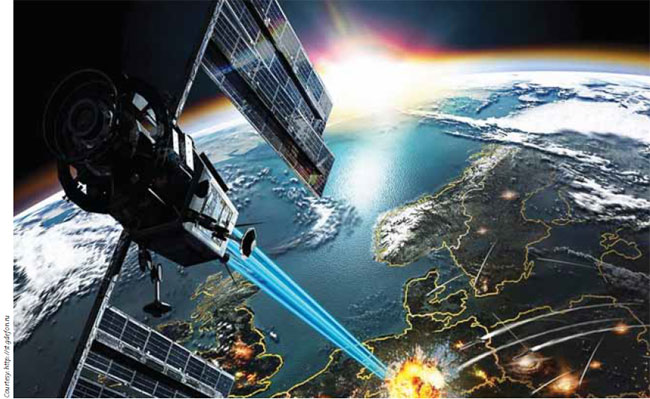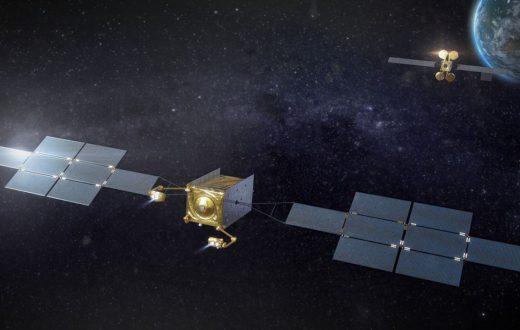For most strategic planners, space represents the ultimate high ground. In the same way that control of the skies added a new dimension to combat in the great wars of the 20th century, the military exploitation of space will be a defining characteristic of the 21st century.
German rocket technology propelled the first unmanned systems into space during the latter stages of World War II. These systems traveled beyond the Karman line — the commonly accepted boundary between Earth and space, at around 100 kilometers altitude (62 miles). From the late 1950s onward, the ability to routinely launch manned and unmanned systems into orbit heralded a new era of competition between the Soviet bloc and the West, led by the United States. As the Cold War progressed, the utilization of the near-Earth environment shaped a new strategic aspect to the conflict and added another battlefield in which the world’s superpowers could compete.
In the standoff between the post-war powers, intercontinental ballistic missiles (ICBMs) were the only weapons to enter space. They were projected on an arc that took them beyond the Earth’s atmosphere before deploying warheads carried by re-entry vehicles to their targets. There were no existing defensive systems that could be stationed in space or close enough to ensure the destruction of the ballistic missiles themselves or of their deadly payloads. The development, staging and maintenance of space-based weapons and bases was untenable at the time, so treaties limiting what could be done in Earth’s immediate vicinity were relatively uncontroversial and easy to pass.
These pacts also hoped to address some of the prevalent fears of the time, including concerns about nuclear explosions in space and about debris descending back to Earth. U.N.-brokered regulations were based on existing Cold War technologies, capabilities and expectations, influenced by the fact that emerging space law was particularly ambiguous. Therefore, existing international law considers the lowest perigee attainable by an orbiting craft: Anything in orbit is taken to be in international space, and anything not orbiting is accepted to be in national airspace. The problem with legal ambiguity, however, is the extent to which gray areas can be exploited for gain.
Yet, as technology improved and countries’ strategic imperatives evolved, so did the consideration given to the domination of space. The announcement of the Strategic Defense Initiative (SDI) by former U.S. President Ronald Reagan in 1983 was heavily criticized, but it proved that the logical evolution of missile defense involved orbital platforms as well as ground-based systems. Although the initiative — known by its more popular moniker Star Wars — did not reach fruition, the United States still achieved global military superiority in the years following the collapse of the Soviet Union.
In achieving military dominance, the United States came to increasingly rely on space-based infrastructure to wage war. While Washington adhered to the prohibition on placing offensive weapons — including kinetic kill systems, directed energy weapons platforms and missile-carrying satellites — in space permanently, the United States installed a huge portion of its electronic networking capability in orbit, enabling it to intervene in conflicts around the globe. Military satellites were the lynchpin of a network-centric approach to operations, comprising command, control, communications, computers, intelligence, surveillance and reconnaissance structures, better known as C4ISR. The evolution of C4ISR coincided with the advent of precision-guided munitions and the drone revolution, enabling the free movement of near real-time data. Everything from GPS, early warning monitoring, weather tracking, tactical and strategic communications, and full-spectrum intelligence gathering is facilitated through the United States’ expansive network of military satellites.
However, the U.S. military is not the sole operator of space-based infrastructure. Countries with advanced space programs, such as China, Russia, Israel, Japan and some NATO alliance members, all rely on some military space-based capability. And the trend is only increasing. As much as the United States leads the field, however, it is increasingly reliant on its space-based systems — of which a significant percentage are highly vulnerable and largely indefensible. This vulnerability has not escaped the notice of the United States’ biggest competitors. By finding a way to disable space-based systems, a potential antagonist could disconnect the multiple interlocking U.S. military systems, plunging it into information darkness and delivering a critical blow ahead of any physical strike — and to do so would not violate any existing space treaty.
Emerging Threats
The single biggest example of this threat to U.S. military orbital systems comes from China. A progression of Chinese anti-satellite missile tests carried out over the past few years has alarmed the Pentagon. Though there are still limitations to the effectiveness of ground-based anti-satellite weapons — namely the tracking and accuracy requirements, given the speed, size and altitude of satellites — the technology is rapidly advancing. For countries that are still developing militarily, there is a strong incentive to pursue anti-satellite technology in the hope it could neutralize or disrupt one of the greatest advantages that the United States has: its C4ISR infrastructure.

Perhaps partly because of concerns over Chinese anti-satellite tests — the most recent of which was conducted Oct. 30 — the Pentagon has recently started to talk about “space control.” And the shift in language could indicate a change to the U.S. defense approach. Washington knows that to be proactive may mean stepping beyond the boundaries of the Outer Space Treaty, and the move would not be without precedent: Reagan showed a willingness to overstep the treaty with his Star Wars program, though he was ultimately stalled because of a lack of political will and technological capability.
The Space Race
As Washington works to secure its orbital technology, it also realizes that competitors are catching up. This is not to say that the U.S. military has been negligent in developing and expanding its capabilities. The United States leads the field in ballistic missile defense (BMD), and many of its maturing systems are designed to operate outside of the Earth’s atmosphere. The United States also dominates space-tracking infrastructure: Being able to see other countries’ space-based systems is beneficial from both a defensive and offensive perspective.
The U.S. Ground-Based Midcourse Defense (GMD) system has the ability to reach into space and to attack ICBMs in the middle of their flight trajectory. A key component of GMD is something known as an exoatmospheric kill vehicle, which separates from its boost vehicle in space and collides with an incoming projectile. This technology does not violate existing space treaties but is revealing of the way military planners — and the defense industries that serve them — are thinking.
Regulation and enforcement is not clear, but the trend is. As militaries around the globe expand their capabilities, so will they increase their reliance on space-based systems. Thus space will become increasingly militarized. The push to expand, occupy and dominate space will eventually erode the efficacy of the current treaty structures set in place decades ago. Currently, all space-based military infrastructure supports terrestrial operations. But long-term considerations about the eventual exploitation of resources in the broader solar system factor into current debates. When space exploration and the collection and refinement of resources become economically feasible, competition will inevitably ensue.
History tells us that such opportunities for resources rarely go smoothly or unchallenged, though deep-sea mining shows us that peaceful competition is possible. Still, generally, competition on Earth has led to perpetual conflict and military posturing, so it is logical that competition for resources elsewhere could inevitably lead to more conflict and could necessitate the ability to project military power there in one form or another. Closer to home, we can look to the opening of the Arctic for comparison: There is no clear precedent for ownership, there are mineral resources present, and only certain countries have the technological know-how to explore and exploit such an inhospitable environment. Countries have already staked their claims and military posturing has begun. As the ability to capture the riches of the solar system becomes more viable, it is highly likely that similar disputes will emerge in the more forbidding environment of space.







